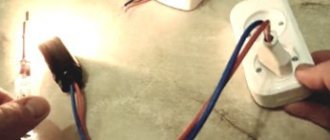The modern era of advanced smartphones and the global Internet offer users the opportunity to use advanced management and control systems. Many people use chillers and VRF systems. But the greatest demand today is for remote control. Thanks to this, you can ensure that the house does not freeze, and that a minimum positive temperature is always maintained in all rooms.
Universal remote system for phone and tablet
Ideal for a classic cottage
In remote regions of Russia, the market offers a relatively small range of heating units. Most often, dachas are heated with compact stoves burning coal or wood; in the best case, the owners of such real estate can install a solid fuel boiler or electric radiators. But even with implemented systems running on diesel fuel and natural gas, universal automatic switching is not always provided. The only viable option in this case is to use electricity. But since the use of such heating units is quite expensive, it is better to use this method as an auxiliary one.
The remote control method allows one or several rooms to be heated to the specified level before the owner arrives, while ensuring the stable functioning of the sewerage and water supply systems. After which you can start the main heating system in a comfortable environment, but only in manual mode.
The evolution of modern technology
High quality GSM sockets
Timely remote switching on of a heater in use in a small dacha using such a device is the best option. It is best if there are two adjacent rooms, and the total number of convectors in power does not exceed 3.5 kW, since this figure is the permissible load for one outlet. Of course, some advanced models allow you to connect an electronic device with a maximum load of 4 kW.
The GSM socket is very convenient and practical to use. The user only needs to connect all the heaters one by one and plug the unit into a regular wall outlet. The device has a special sensor for measuring the ambient temperature. If there are many rooms in the dacha, and all the heaters are plugged into one outlet, then in the main room the air will warm up to the required level, but in all the others it simply will not have time. The whole point is that the infrared temperature sensor will switch off exactly at the moment when comfortable conditions are created in the room where the GSM device is located.
Important! The adapters in question do not have a battery, which is why in the event of an unscheduled power outage they also cease to perform their functions. The device will inform the user in advance about the current situation. After 3 minutes the system resets. After turning on the power, you must again make the desired request and send the command.
Only advanced models can boast of having an autonomous power source. Such a device retains all the settings made even after the power supply is restored.
Remote control using a smart plug
If there is no need for a ready-made complex, and the task is to turn on/off electrical appliances according to a given algorithm, buy a smart socket. This is the easiest way to manage devices remotely. Indeed, in most cases it does not require special knowledge and can be installed by a competent electrician.
Depending on the needs of the user, the sockets differ in functions. They can be used:
- timers;
- temperature sensors;
- interface for Internet connection (Wi-FI, GSM, Ethernet).
Such sockets can be included in the alarm system.
These devices allow you to configure automatic algorithms for turning on electricity consumers. With their help, the status of connected devices is monitored. Mobile and computer programs are used for control. The most obvious way to use smart sockets in a country house or country house is to connect a heater.
Xiaomi, Alonio, Digma sockets are popular. Their cost ranges from several hundred to five to six thousand rubles (depending on functionality).
High quality GSM block module
This device should be included in the electrical circuit if the house has a large area and many rooms. This block module does an excellent job of controlling all convectors in the house via a contactor, power relay, or expansion relay boards. In this case, professional installation will be required. There is enough free space in the internal compartment of the device to install a SIM card. It is better to choose an operator that has reliable signal distribution; you also need to remember to deposit money into your account.
The module is equipped with a battery that supports autonomous operation for 12 hours. In this case, manufacturers have provided a whole list of commands for controlling convectors; the user can also independently connect additional options to increase the autonomy of the product. The following functions are available from a regular mobile phone:
- Maintaining optimal temperature of heaters.
- Simultaneous connection of up to 5 sensors using a contactor.
- Remote adjustment of temperature control settings in the entire house or individual rooms.
- Using a backup battery.
- Continuous monitoring of the presence of 220V voltage in the network.
- Automatic display of information about the temperature in the house.
- Emergency notification via SMS about failure of engineering equipment.
Demanded GSM based system
Control of district heating boilers
For example, we used the GSM alarm controller Block-Post 4, manufactured by EDS LLC.
This device allows you to control the temperature in 8 zones at a distance of up to 100 from the main device. Although the device is intended primarily for an alarm system, its latest firmware has extensive capabilities for working with temperature indicators and the corresponding external periphery:
- Range of perceived measurements -40°С…+120°С with an accuracy of half a degree;
- There is built-in protection against freezing of the coolant; you just need to indicate which channel receives information from the detector and the limit value. If it is exceeded, an SMS warning is sent;
- There is a WEB interface with the ability to maintain statistics and visualize temperature graphs for the period for each temperature sensor;
- You can program the maintenance of a given temperature regime and the prevention of freezing of the heating system.
This device has several advantages compared to others regulating the same functionality. First of all, all modules, including the GSM modem and UPS (up to 12 hours of autonomous operation), are built inside the case, which greatly simplifies its installation and configuration. After the SIM card is installed, the controller automatically connects and registers on the developers’ WEB service, which is located at https://monitoring.gsmbps.ru/. Using standard visualization shell tools, you can easily program the device to perform many functions without knowing any programming language. Connection directly to the boiler is made through relay outputs.
In addition, developers are constantly improving both the hardware of the device and firmware, as well as the software on the server. The only limiting factor to the widespread use of BlokPost controllers is their rather high cost and poor compatibility with devices from other manufacturers.
Carrying out control stationary, as well as using SMS commands
To turn on the heaters in a timely manner, you need to place a classic SIM card in the module. The necessary command is transmitted from any smartphone, after which the device will communicate with the control unit and the convectors will be configured via radio signal. You can also install a universal program, thanks to which you can specify the following parameters: on and off times, room temperature. In remote mode, you can completely reconfigure the system. In addition to this, the unit is equipped with outputs for connecting to alarm sensors.
An accessible and easy-to-use device
Multifunctional Wi-Fi
In this case, experts recommend using Energy Control. You can download this program to any phone, which stands out for its versatility and practicality. The purchased unit is connected to the router and provides a good connection to the Internet. At work or while driving around the city, you can control convectors, adjust the air temperature, and monitor the performance of the entire system. You can simultaneously make all the necessary corrections from more than 250 smartphones.
Important! Today, Nobo is the only company that is actively working in this industry. Specialists continuously modernize and expand the functionality of the equipment they sell.
The video provides instructive information on how you can remotely control your home heating:
Heated floor control
In each case, the choice of controller for a system for remote control of a heated floor via the Internet depends on the installation option used:
- circulation pump control;
- using a thermal head;
- servo control;
- three-way valve control;
- installation of a weather-compensating controller;
- group adjustment.
I will not dwell on this in detail, since the topic of preparing a heated floor deserves a separate article.
Warm floors can be used not only at home, but also in the bathhouse...
In this case, the operating principle is quite simple. Heat regulators receive information from temperature sensors and execute the program specified by the user. Depending on the system used, zone control is also possible.
To set up remote control of water heated floors, equipment from the Polish company TECH Controllers is required. In general, any heat regulators are suitable. You can buy models whose characteristics include information about the presence of a built-in GSM modem.
Remote systems NOBO Energy Control
It is quite easy to use such developments of specialists. Control is carried out through a single center - Orion 700 devices. Auxiliary elements allow you to remotely control absolutely all electrical appliances and convectors. The user can remotely control energy consumption. Experts made sure that the temperature was maintained exactly to 1 °C. Radiators are turned on and off according to a given program, and the universal built-in timer can be programmed not only for a day, but also for a whole week. Thanks to this, the final electricity consumption is reduced by 30%, but without compromising the comfort of living.
Activation of heating at a certain time
To create optimal living conditions at your dacha, you can set your arrival time in advance. This option suits many modern users with its accessibility and simplicity. To work, you need to purchase a reliable automation relay. The timer is installed in a circuit with an electric heater and the optimal turn-on time is simply set.
Advice! If arrival at the dacha is planned at eight in the morning, then you need to set the relay for 5 o’clock. During these 3 hours, the air in the rooms will warm up well.
To significantly save money, heating can not be turned on in all rooms. In the living room and bathroom it is enough to bring the temperature to +12 °C. Even if a person comes in from slightly frosty conditions, such conditions will be comfortable. To avoid wasting electricity if the train is cancelled, you can turn off the heating remotely.
A popular device for remote use
Sending commands from a smartphone
This option is more convenient to use, but you need to spend more money on it. In order to send a remote command that will notify the equipped system that it is time to prepare for the arrival of property owners and turn on the heating, you need to buy a GSM module. This device is a regular switch that is responsible for connecting when calling from a phone. You can enter several numbers into the unit’s memory at once, calls from which will be perceived as commands. The product must be installed in a common switchboard and high-quality electric radiators are connected through it. To have a warm room waiting for you upon arrival at your dacha, you just need to call from your smartphone or send an SMS. If you had to be delayed or the train was suddenly cancelled, then just make another call to turn off the heating.
Important! The device fits perfectly with a SIM card from any mobile operator. It is best to opt for the option that provides the highest quality communication in a certain region.
Self-installation of purchased socket
Devices for "smart home"
Statistics say that the most popular home automation project is creating a security system. The creation of home theaters and home music control systems is in second place, followed by light and energy control. Then comes the integration of several systems with each other.
There are many product lines for different standards. Here we will show just a few examples of what we think are interesting automation devices that will allow you to make your home or apartment “smarter.”
Maintaining positive temperature in the house automatically
Water supply is directly related to heating. If you rarely go to your dacha in winter, then you shouldn’t be too smart about the water supply. You can bring the necessary supply of liquid with you for several days, or store it in capacious plastic containers from the summer. If the dacha is visited quite often, and the water is used not only for drinking, but also for showering and sewage, then this property is used as a country house. In this case, smarter systems are needed than the classic remote switch.
If the house is periodically subjected to freezing and thawing, this is fraught with accelerated deterioration of the property’s finishing, which will force the owners to spend additional money on unscheduled repairs.
The assembly of more complex remote systems needs to be done if it is planned not only to provide high-quality heating of rooms, but also to electrically heat sewerage and water supply systems, as well as constantly maintain positive temperatures. Expensive models of boilers that operate on gaseous or liquid fuel and are equipped with a thermostat are equipped with similar functions.
Important! Heating of water pipes is based on the fact that they are wrapped in a spiral with a heating cable cord, and then covered on top with a warm sleeve, which is made of foamed polyethylene.
Affordable GSM device from a domestic manufacturer
Smart home technologies
Before you start buying smart home devices, let's understand a little about the technologies that are used in these devices. There are several different communication standards or protocols that these devices use to communicate with each other and the management controllers. Some devices are connected by wire, some by wireless, and some use both. Be sure to check what protocol the device uses before purchasing it so that all your purchases are compatible with each other.
X10. This is the oldest of the home automation protocols, which appeared back in the 70s of the last century (sounds terrible, but this is only about 40 years ago, and not during the time of Sherlock Holmes and the activities of the People's Will). Now it is used for both wired and wireless communications. X10 is not characterized by insane speed or ultra-reliable communication between devices in a home automation network, however, this standard has long been debugged and many still prefer to use X10.
ZigBee. This is another name for the IEEE 802.15.4 wireless standard, which is used by a group of manufacturers that make up the ZigBee Alliance. The main advantage of this standard is that it creates a mesh network in which most devices have equal rights and communicate with each other on equal terms. A mesh network offers increased reliability and resilience. When one of the nodes stops functioning, the other nodes continue to work, connecting to each other directly or through other intermediate nodes. In addition, this connection consumes very little power.
Z-Wave. Another wireless protocol belonging to one company - a chip manufacturer, including for smart home systems Sigma Design.
Insteon . This is perhaps the best protocol that combines a power line communication protocol with a wireless protocol. Both work as a mesh network. All nodes in the Insteon network are equal and can communicate with each other. If one node fails, communication goes through others. The protocol developer is Smartlabs. The protocol is compatible with X10.
WiFi. This network protocol is now used not only by computer systems. Very fast, works well. And it is not surprising that some manufacturers began to make products for the “smart home” that take advantage of the advantages of this protocol. Other protocols consume less power and use less bandwidth, but WiFi's capabilities are much greater.
HAI . This is the protocol used in professional installations costing more than $50 thousand. We will leave it aside for now.
Remote automatic heating of a standard dacha as an integral part of the overall scheme
A professional approach to real estate heating allows the equipment involved to function stably in various modes. With the right approach, you can combine several systems at once to achieve a good result. This remote correction option does not have a central controller. But at the same time, a fairly large percentage of the unused capabilities of the units can be used in other “smart home” schemes. Even a classic GSM module is capable of not only receiving incoming calls, but also sending reports about the situation in the house to a smartphone. Thanks to this, you can quickly find out about a flood or a starting fire.
Planning a smart home
Before you rush to buy those interesting devices that we will describe below, you need to plan everything in advance and decide on your goals. To do this, you need to make a short list of your actions.
- Define your goals. Do you want to control your home by phone and check the bathroom temperature from anywhere on the planet, or are you a little more modest in your desires? Write in detail what you ideally want to receive. The right approach is to start small, but knowing what you want to achieve in the end is key to successfully completing the project. Try to figure out what will be most useful to you. Start with the security system, for example. Or here are a few other examples. Vacation system. Press one button on the keyboard and the heating will be turned off, the security system will be in the “On” mode, and the lights will turn on in the evening in a certain order to simulate the presence of people at home. Or a mode in which, if the front door rings, an image of the caller is sent to your phone, and you get the opportunity to have a two-way conversation with him. And you can decide whether to remotely open the door for him (and then lock it after he leaves).
- Choose a standard for home automation. In principle, you can use any one. The main thing is to decide in order to select the right devices. X10 and Insteon dominate now. Both are uncomplicated, the X10 is somewhat cheaper, and the Insteon can handle a lot of data.
- Determine the phases of system installation. Smart home devices make life better, but if you decide to immediately install large-scale devices, then after a while you may decide that you were in vain about it. Break the process down into stages, make sure all the devices you installed at this stage are working, and only then proceed to the next stage. The more detailed you draw the installation diagram, the easier your life will be when carrying out the work.
- Select a control system. For example, Activehome for X10 is an easy-to-use solution, but with somewhat limited functionality. Or Powerhome is a good choice, but difficult to learn. Some systems allow you to use voice control, but they are not very friendly with the Russian language. Selected solutions allow remote access to control.
- Install the computer that controls the system . This computer needs to run 24/7, so choose a location where it won't disturb anyone. Install the software, connect the X10 controller (or other standard of your choice).
- Install home automation devices and modules. The number and list of devices and control modules depends on your plan. There are many of them, we will not dwell on specific devices here, for example, if you use X10, then to control, say, a garage door, you can use a universal module. There are modules for lamps, or wall switches, most of them are very easy to connect. We will talk about some devices below.
And a couple of comments.
- To save electricity, use additional sensors that allow, for example, the system to automatically turn off the lights when you leave the room.
- Where possible, use wired switch-type modules rather than plug-in modules. This will allow you to control lights and devices without using a smart home control system if, God forbid, something in it breaks.
- Keep in mind that automation requires understanding what you're doing, especially when you're dealing with electricity. Wrong actions can be dangerous for you.
The feasibility of remote control of functioning heating
Various heating cables, radiators, and boilers are responsible for the most comfortable air temperature in the house. Each unit has its own operating principle and heating functions. The main task of the created system is to heat the room with minimal financial losses. Having remotely set the optimal parameters of the desired temperature, the user sets a specific control program. Control can be carried out either automatically or manually. Thanks to this, the rooms will be maintained at the most suitable temperature. This approach allows you to control the functioning of not only the entire system, but also individual working units, which is very convenient and practical. The equipment will independently make the necessary adjustments when it gets warmer or colder outside.
Rational use of electric heaters in a private home
Main advantages
The main positive characteristics of the remote heating control method include:
- Significant cost savings on heating rooms (up to 60%). This effect is achieved due to the fact that in the absence of the owners the boiler can operate in an economical mode.
- Providing additional comfort and coziness.
- For high-quality engineering systems, a real development trend can be considered the possibility of combining them into a single network. Due to this, you can reduce the overall financial costs of maintaining the dacha.
- Significant extension of the service life of devices, ensured by the operation of parts at reduced loads.
Experts have proven that the capabilities of devices for remotely sending operating parameters are becoming more advanced every year. Developers of multifunctional applications for smartphones create innovative devices on the principle that even an untrained person can easily handle them. Now, even over a long distance, you can prevent pipes from defrosting during the cold season. The zonal mode of operation is in great demand, when different rooms can have individual temperatures.
Remote reconfiguration means that any indicators can be changed using a smartphone. It is this approach that is one of the key parts of the ideology of promoting a “smart home”. This approach entails the further rapid development of all engineering systems of the dacha in order to ensure the most convenient creation of comfortable living conditions.
More informative information on this topic is presented in the video:
Average score of ratings is more than 0
Share link
Comments There are no comments yet, but you could be the first...
Why do I need a smart home?
Automation makes your life easier and better in your home or apartment, moreover, it saves time and money. Here are a few reasons to start creating your smart home.
- Automation improves efficiency. This applies both to the efficiency of individual systems in your home and to the efficiency of the entire household. For example, because the automation system can control multiple devices, you can turn off thermostats and turn off lights with the touch of a button when you decide to go on vacation. You won't have to worry about forgetting to do something.
- Automation saves you money. Only smart control of lighting, heating, ventilation or air conditioning can reduce energy costs by 15-20%, according to automation system developers. For owners of their own homes, this also includes the opportunity to use non-standard heating or cooling systems, which also dramatically reduces electricity costs and allows them to quickly recoup their investments in a smart home.
- Automation is convenient. The ability to control many electronic devices (lights, heating, audio/video, curtains and doors, locks, security systems, etc.) using one touch device on the wall or just a smartphone - this alone makes you think about home automation.
- Automation creates comfort. The ability to actively control the various electronic elements of your home provides comfort in which the environment around you - from installing the lighting to turning on the stereo - begins to obey you.
- Automation provides peace of mind . A home device control system allows you to avoid problems that may arise due to forgetfulness or inability. From anywhere you can check whether everything is normal in your home and, if necessary, make corrections using your smartphone.











